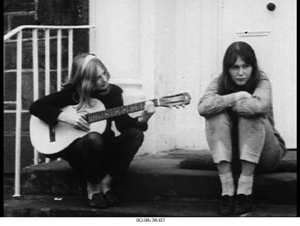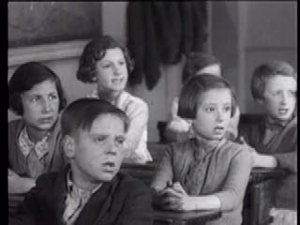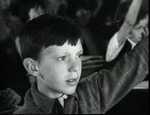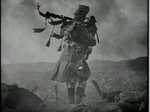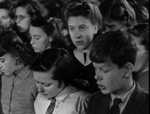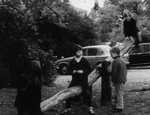Experiences of School
- Introduction
- Lesson
- Film Clips
- Print All
Introduction
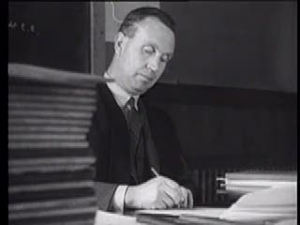
This lesson guide is about going to school in the past. In this lesson you can explore how education was represented in some Scottish documentary films between the 1930s and the 1950s.
The lesson guide introduces discussion topics such as education and values, and the student voice.
Lesson
The Children’s Story was produced by the Films of Scotland committee as one of a series of films produced for the 1938 Empire Exhibition in Glasgow. The films were commissioned by Secretary of State for Scotland Walter Elliot to cultivate a sense of national pride in Scotland. They enjoyed enduring popularity in UK cinemas, with an estimated audience of 22 million in British cinemas. The film certainly has elements of propaganda in its unrelentingly positive depiction of the Scottish Education system.
- The film was made in 1938. What was the world like then? Does anything surprise you about what isn’t included in the film?
The film was made under the supervision of John Grierson – the self-professed socialist and key figure in the documentary movement. We may be surprised that such a ‘radical figure’ (who was questioned in Canada in the 1940s about being a possible Communist spy) crafting such powerful propaganda for the British Government. However, Grierson had great belief in the state as a benevolent tool for social progress, and the role documentary could have as a tool of ‘public education’. He saw propaganda as ‘Education… we are giving every individual a living conception of the community which he has the privilege to serve.’
In what ways does the film convey an upbeat message about Scottish Education? Think about choices of music/editing/voiceover/language/setting.
Listen to the speech made by Sir William McKechnie at 12.25 about the values of Scottish Education in 1938. What effect does the montage over this speech have? Compare recent policy documents on Scottish Education. What has changed?
Education and Values
Ever since the arrival of universal education (a legal requirement in Scotland since 1872) debate has centred on what education is for. Is it for the development of skills which will be directly relevant to later life, or about more general development of ‘rounded people’?
Before watching the group of films selected here, create two top five lists with students: 1) What education should be for 2) What education is used for? Another of the 1938 Empire Exhibition films made under the supervision of John Grierson, was The Face of Scotland, which has a short section on the history of the Scottish Education system as being rooted in the values of Presbyterianism (06.30 - 08.30).
What impression is given of what life is like in one of the ‘great Scottish Universities’? How does film language (e.g. use of lighting, shot angles, voiceover) create this impression?
Compare the view of higher education in The Face of Scotland with promotional videos for the ‘great Scottish universities’ today.
Which values are emphasised nowadays? What different/similar film techniques are used?
Look again at The Children’s Story: note down negative perceptions which the film gives of education in the past (e.g. ‘the academic grind’). What aspects of education in 1938 as seen in the film look ‘dated’ from the perspective of today?
In what ways does The Children’s Story seems to reflect the view that education is a communal rather than individual activity?
Despite being called The Children’s Story, do we have any sense of the individual voices of children in the film?
The Students’ Voice?
The idea of a student council is very common nowadays; perhaps you have one in your school? If so, do you feel it is effective as a way of giving students a say in running the school? The film Cally House, about a boarding school for evacuees from the city during World War Two shows a ‘school parliament’ (07.58) representing students’ views – which would have been very unusual at the time.
Look at Cally House. How does the film language used emphasise community rather than individuals?
Cally House was made by the Ministry of Information during World War One. Find out who the MoI was. Does having that knowledge change how you see the film?
Does any of the action in Cally House or The Children’s Story seem staged?
Testing and Judgements
The verbal language of The Children’s Story may strike us as inappropriate, with its talk of ‘defective’ and ‘neurotic’ children (05.40). Also we may question the value of the heralded new ‘intelligence’ test to gauge the potential of a pupil (07.20)
Can you answer the three questions on the ‘intelligence test’? If you were devising your own test to gauge children’s potential, what types of thing would you include?
The sequence (08.00-08.45) in The Children’s Story contrasts traditional schools which prepare students ‘for the professions’ with modern schools which emphasise ‘variety of interests’. How does the filmmaker make the more modern schools seem appealing?
Debate – Are Exams a Good Thing? What might others ways of measuring learning be? Do we really need to measure ‘attainment’? The debate could lead to film or multimedia essay.
Further Ideas
- Grierson called documentary the ‘creative treatment of actuality’ – does this give a film like The Children’s Story any more claim to being a ‘true’ depiction of what education is like then fictional work such as television series or feature film?
Create a multimedia essay called ‘What School Should Be Like’. This should reflect what your ideal education would be like. Download and edit in footage from the films here to illustrate your ideas.
Compare these film representations of Scottish schools with literature such as Liz Lochhead’s 'The Teachers'.
Create a one minute promotional video for your school, using some of the film language techniques which you found effective in this group of films.
This lesson guide was written by Scottish Screen Education Development Manager, Adam Seddon.
Revised June 2020
